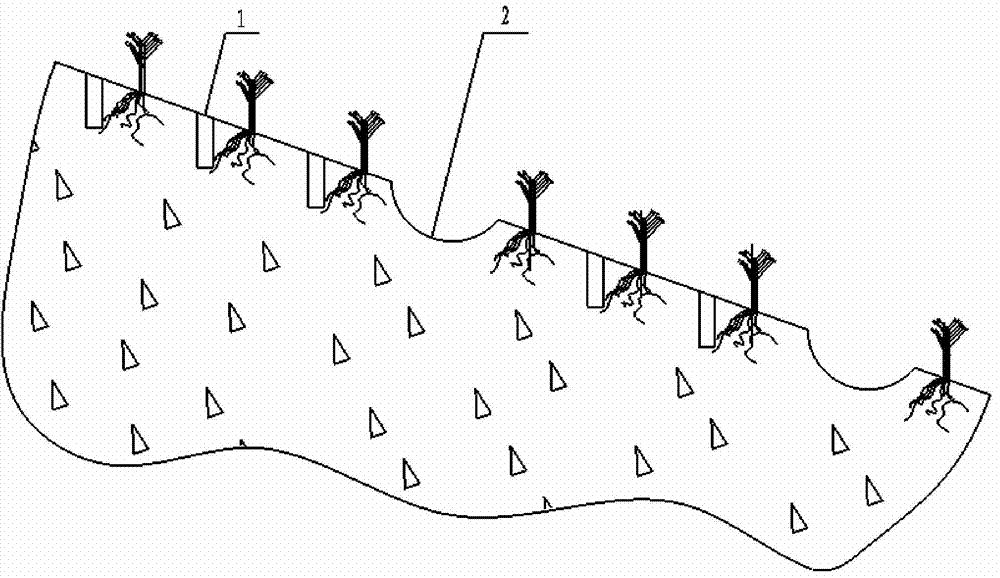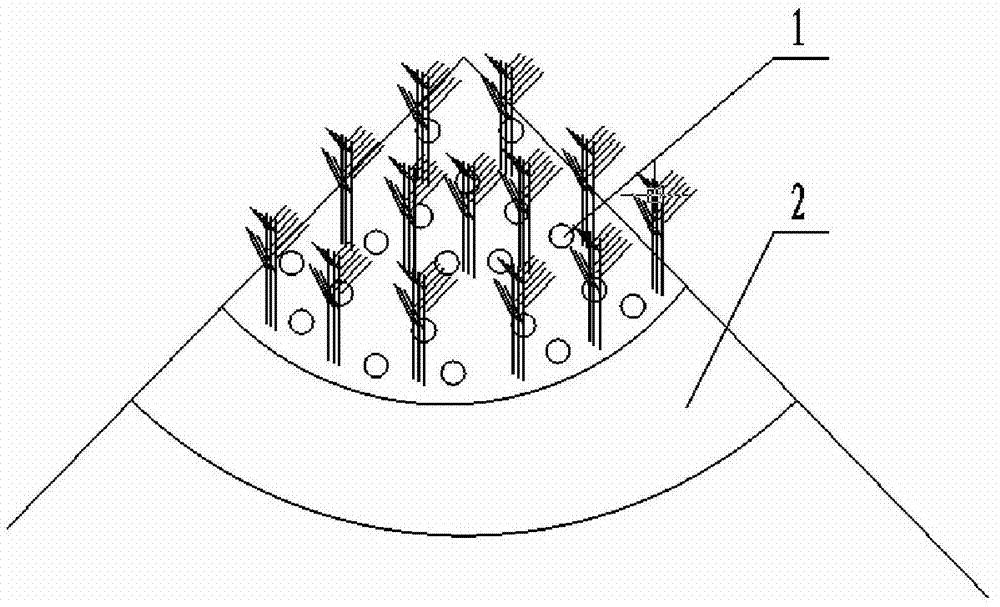Slope cropland ramie cultivation method
A cultivation method and technology for sloping cultivated land are applied in the field of ramie cultivation in sloping cultivated land, which can solve the problems of easily causing ecological damage, large changes in the original state of the sloping land, large amount of earthwork, etc. The effect of small amount of soil and stone works
- Summary
- Abstract
- Description
- Claims
- Application Information
AI Technical Summary
Problems solved by technology
Method used
Image
Examples
Embodiment 1
[0027] Such as figure 1 with figure 2 As shown, ramie is planted in rows on the sloping farmland. The rows of ramie are basically distributed along the contour line. The distance between the rows is 600 mm. Holes are set between the rows of ramie. The width of the water storage belt is about 1000mm and the depth is about 500mm, and the water storage belt is filled with humus with high water absorption rate. Using this method to cultivate ramie on sloping farmland, it can accumulate about 0.15m3 per square meter at most when there is sufficient rainfall. 3 Even if the sloping farmland is dry and rainless, ramie still grows well and can produce stable and high yields.
Embodiment 2
[0029] As described in Example 1, however, holes with a size of 200mm, a depth of 250mm, and a spacing of 600mm are used. Since the holes are far apart, in order to effectively collect rainwater, the bottom of the hole is used to dig out the diversion diagonally upwards. Inclined ditch, so that rainwater collects into the hole along the inclined ditch (such as image 3 shown). Using this method to cultivate ramie on sloping farmland, it can accumulate about 0.15m3 per square meter at most when there is sufficient rainfall. 3 Even if the sloping farmland is dry and rainless, ramie still grows well and can produce stable and high yields.
Embodiment 3
[0031] As described in Example 1, but when the ramie is cultivated, the water-retaining agent and the fertilizer are mixed with the soil and backfilled into the holes, and the weight ratio of the water-retaining agent to the soil is 2-3‰. This is to use the characteristics of water and fertilizer and callus growth of the root system of ramie plants to promote the development of the root system around the hole and form a water and fertilizer supply and transportation center with a large root hair density, which is conducive to long-term performance of the water-retaining agent and fertilizer. Using this method to cultivate ramie on sloping farmland, it can accumulate about 0.15m3 per square meter at most when there is sufficient rainfall. 3 rainwater, saving 600m of irrigation water per mu per year 3 and can realize stable and high yield of ramie, improve fiber quality, increase ramie plant height by 27%, stem diameter by 22%, and increase yield by 25%.
PUM
 Login to View More
Login to View More Abstract
Description
Claims
Application Information
 Login to View More
Login to View More - R&D
- Intellectual Property
- Life Sciences
- Materials
- Tech Scout
- Unparalleled Data Quality
- Higher Quality Content
- 60% Fewer Hallucinations
Browse by: Latest US Patents, China's latest patents, Technical Efficacy Thesaurus, Application Domain, Technology Topic, Popular Technical Reports.
© 2025 PatSnap. All rights reserved.Legal|Privacy policy|Modern Slavery Act Transparency Statement|Sitemap|About US| Contact US: help@patsnap.com



